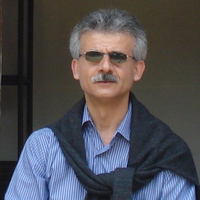Papers by Alexander Berghaus
Archives of oto-rhino-laryngology
A comparative animal study showed that, after implantation in skull defects in guinea pigs, porou... more A comparative animal study showed that, after implantation in skull defects in guinea pigs, porous high-density polyethylene (PHDPE) was substantially better anchored in the bone than Proplast, and had greater stability of form and structure. In Proplast, ingrowth of fibrous tissue caused partial structural dilatation and fragmentation, which could limit its suitability for use in reconstructive surgery.
MMW - Fortschritte der Medizin, 2011
Laryngo-Rhino-Otologie, 2007
Implants shorten reconstruction, reduce trauma for the patients, are, in principle, of unlimited ... more Implants shorten reconstruction, reduce trauma for the patients, are, in principle, of unlimited availability and can be given definable qualities Alexander Berghaus 1 that outnumber those of biological transplants. Lots of sometimes 1 Department for Otorhinolaryngology, Head exotic materials have already been suggested for facial surgery and most of them have turned out to be unsuitable in the short or long term, and Neck Surgery, because they did not satisfactorily fulfil the requirements of a "perfect Großhadern Medical Center, implant". However, transplants obviously cannot be regarded as ideal

Efficacy of once-daily esomeprazole treatment in patients with laryngopharyngeal reflux evaluated by 24-hour pH monitoring
Otolaryngology–Head and Neck Surgery, 2007
Objective Laryngopharyngeal reflux (LPR) is generally treated with twice-daily proton-pump inhibi... more Objective Laryngopharyngeal reflux (LPR) is generally treated with twice-daily proton-pump inhibitor (PPI) therapy. In this study, the efficacy of esomeprazole 40 mg once-daily together with lifestyle modifications was determined by repeated 24-hour pH monitoring. Study Design and Setting A prospective study. Fortynine patients with suspected LPR underwent 24-hour pH monitoring. Twenty-seven of 49 patients with measurable abnormal proximal reflux reflected by a reflux area index (RAI) >6.3 were treated with esomeprazole 40 mg every day, and a second pH study was performed. Results In 22 of 27 patients, everyday PPI treatment reduced the RAI. Four of 5 patients with no RAI reduction reported on symptomatic relief. Conclusion In a considerable number of patients with suspected LPR, pH monitoring reveals no abnormal proximal reflux. Esomeprazole 40 mg every day together with lifestyle modifications could reach adequate acid suppression in a large number of patients. Symptom improvem...
A New Upper-Lid Implant for Facial Palsy
topathy and gain of visual acuity. Complications that have been assessed include astigmatism, bul... more topathy and gain of visual acuity. Complications that have been assessed include astigmatism, bulging, migration, pseudoptosis, and extrusion of implants. We evaluated histological samples of the implant bed and performed ultrasound measurements of the tarsal radius. Results: The restoration of lid closure was a visual and aesthetic improvement for all patients. We found a ten- dency toward a higher rate

Scars after total ear reconstruction with porous polyethylene: the patients’ perspective
European Journal of Plastic Surgery, 2013
ABSTRACT Background Total ear reconstruction with porous polyethylene implants leads to three typ... more ABSTRACT Background Total ear reconstruction with porous polyethylene implants leads to three typical skin scars: a scalp scar from harvesting the temporoparietal fascia flap as well as a groin scar and a contralateral postauricular scar from harvesting full-thickness skin grafts. This study evaluates the annoyance of these scars from the patients’ perspective. Methods Fifteen patients received structured questionnaires covering the aesthetical outcome and daily impairment by the three scar types, as well as validated questionnaires measuring health-related quality of life. Results The ear reconstruction had raised the health-related quality of life in 14 patients. The scalp and groin scars were rated “satisfactory,” and the postauricular scar was “good” on an average. In contrast to the postauricular scar, the annoyance by scalp and groin scars was substantial: Half of the patients had sensation disorders on the scalp or groin. The scalp scar impaired a third of the patients wearing a desired hairstyle and the groin scar a third of the patients wearing swimsuits. A fifth of the patients experienced feelings of shame in the public due to the scalp and groin scars. Conclusions While not preventing the beneficial effect of ear reconstruction on patients’ health-related quality of life, scalp and groin scars are annoying for a relevant percentage of the patients. Therefore, the temporoparietal fascia flap should be harvested with the smallest incision possible, full-thickness skin grafts from the groin should be harvested as small as possible, and harvesting areas for full-thickness skin grafts other than the groin should be evaluated. Level of Evidence: III.

Nasal reconstruction in advanced sinunasal sarcoidosis
Rhinology Journal, 2009
Sarcoidosis can lead to devastating nasal deformities and impairment of nasal respiratory functio... more Sarcoidosis can lead to devastating nasal deformities and impairment of nasal respiratory function. There is only very little published experience with nasal reconstruction in this disease entity. In general, a cautious attitude prevails out of fear of complications or failure due to the underlying granulomatous inflammation. A 57-year-old lady presented to our institution with a 20-year history of sarcoidosis with sinunasal involvement. The findings included a saddle nose deformity, absent nasal septum and conchae, left-sided alar collapse and cutaneous involvement of the nasal tip with discoloration. In a first procedure, we performed a reconstructive nasal surgery with porous polyethylene grafts. In a second procedure, we used a paramedian forehead flap for a partial nasal reconstruction. The functional and asthetic improvement was very satisfactory for the patient during the 2-year follow-up period. This is the first reported use of a forehead flap in nasal sarcoidosis. It demonstrates that major reconstructive nasal surgery and implantation of porous polyethylene grafts can successfully be performed in patients with sinonasal sarcoidosis during remission.

Ear reconstruction with porous polyethylene implants
Advances in oto-rhino-laryngology, 2010
This article describes a surgical technique using porous polyethylene as the framework material f... more This article describes a surgical technique using porous polyethylene as the framework material for ear reconstruction. In comparison to the use of rib cartilage, porous polyethylene - first described by Berghaus in 1982 - provides better definition and projection as well as congruency with the opposite side. Hospitalization time is significantly shorter. There are less surgical interventions than with traditional microtia operations that use rib cartilage, and the patient is spared the additional procedure needed to remove the rib cartilage, with all the associated complications as well as the resulting thorax scar. Also, reconstruction can take place at an earlier age, which is advantageous for those concerned. Using porous polyethylene as the frame material, a temporoparietal flap and full-thickness skin cover, we have been able to achieve very convincing results over recent years.

International journal of pediatric otorhinolaryngology, 2009
Functional endoscopic sinus surgery (FESS) is not frequently performed in children. The aim of ou... more Functional endoscopic sinus surgery (FESS) is not frequently performed in children. The aim of our retrospective analysis was to determine symptoms, surgical extent, complications and outcome of operated children. For a period from 1994 to 2004 the clinical records of the Department of Otorhinolaryngology, LMU Munich, Germany, were screened for pediatric FESS procedures. Subsequently, a retrospective chart review was performed in all cases. For assessment of outcome, symptom- and quality of life-related questionnaires were sent out to all patients. 115 children had a FESS procedure due to CRS, 77 were boys and 38 girls. The response rate of the questionnaires was 64% (73 of 115); the mean follow up of these was 5.4 (+/-1.8) years. 76% of the patients reported an improvement of their chief symptoms and 71% of their general quality of life. The overall quality of life had improved significantly (p<0.01) on VAS. In CRS patients nasal obstruction was completely relieved in 62.3%, fac...

Porous polyethylene implants in revision rhinoplasty: chances and risks
Rhinology, 2007
High density Polyethylene (PE) is a chemically pure, porous plastic implant material that can per... more High density Polyethylene (PE) is a chemically pure, porous plastic implant material that can perform supportive functions. The material has good tissue biocompatibility and permits ingrowth of connective tissue with related vascularization. The material is being used more frequently in nasal surgery. In this study we describe possibilities and limitations in the use of PE in rhino-surgery. Thirty-two charts of patients with rhinoplasty and PE-implantation were reviewed. All patients were seen in our department again. A database was created which included the following parameters: date and exact area of implantation, shape and thickness of the implant, number of revisions, technique of prior rhinoplasties, complications and the patients' satisfaction. Seventy-five percent of patients were revision rhinoplasties at the time of surgery. Seven out of thirty two (21%) patients developed a complication. In four cases, the complication was managed with total explantation; three patien...
[Hardness of hearing should be treated at the latest from the age of three months. Babies who don't hear don't learn to speak]
MMW Fortschritte der Medizin, Jan 11, 2006
[Chronic inflammation of the upper airways. Operation instead of antibiotic]
MMW Fortschritte der Medizin, Jan 29, 2005
Oto-Rhino-Laryngologia Nova, 1992
Hidden Columella -Raffinesse der funktionellen und 225 (Lausanne/Berlin) ästhetischen Korrektur (... more Hidden Columella -Raffinesse der funktionellen und 225 (Lausanne/Berlin) ästhetischen Korrektur (Hidden Columella -Finesse of Functional and Aesthetic Correction) Berghaus, A. (Berlin) Eine neue Trachealprothese. Experimentelle und erste 232 klinische Erfahrungen (A New Tracheal Prosthesis. Experimental and First Clinical Results)

The Laryngoscope, 2012
Objectives/Hypothesis: Contrast-enhanced ultrasound (CE-US) can be used for noninvasive analysis ... more Objectives/Hypothesis: Contrast-enhanced ultrasound (CE-US) can be used for noninvasive analysis of functional vascularization. Chronically recurrent sialadenitis due to sialolithiasis of the submandibular gland is associated with increased vascularity. The aim of this investigator-initiated clinical trial was the evaluation of CE-US as a quantitative monitoring technique during gland-preserving extracorporeal shock wave sialolithotripsy (ESWL). Study Design: In this prospective clinical evidence level 2c study, perfusion in patients (n ¼ 10) with unilateral sialolithiasis of the submandibular gland was quantitatively analyzed using CE-US before and after ESWL, comparing with the respective contralateral gland. Methods: Before CE-US measurements, a subjective clinical score of complaints (range, 1-10) was documented. The contrast agent SonoVue was injected into a cubital vein. The intensity-time curve gradients (ITGs) were calculated from CE-US data. Results: The ITGs derived from CE-US measurements revealed higher perfusion in the affected submandibular gland compared to the contralateral side. In parallel to clinical complaints, parametric CE-US data were significantly reduced after ESWL in chronic sialolithiasis-associated sialadenitis. Conclusions: CE-US-derived ITGs appear to be an independent and quantitative marker for treatment effects of ESWL. Clinical experience and further studies will have to validate this method as a diagnostic tool to decide especially whether to proceed to sialoadenectomy in therapy-refractory cases.

Assessment of functioning in patients with head and neck cancer according to the International Classification of Functioning, Disability, and Health (ICF): A multicenter study
The Laryngoscope, 2009
To assess the level of functioning in patients with head and neck cancer (HNC) using the the Inte... more To assess the level of functioning in patients with head and neck cancer (HNC) using the the International Classification of Functioning, Disability, and Health (ICF). Multicenter study at nine different study centers in four European countries. Data collection included structured interviews according to the extended ICF checklist with 145 HNC patients and completion of the European Organization for Research and Treatment of Cancer-Quality of Life Questionnaires (EORTC-QLQ). The generic ICF checklist was extended by additional HNC-specific categories identified in six HNC-specific questionnaires: EORTC, University of Washington Quality of Life (UW-QOL), Functional Assessment of Cancer Therapy scale (FACT), Performance Status Scale for Head and Neck cancer patients (PSS-HN), Head and Neck Quality of Life instrument (HN-QOL), and Voice Handicap Index (VHI). The ICF qualifier system was applied on a scale from 0 (not impaired) to 4 (completely impaired), as well as &amp;amp;amp;amp;amp;amp;amp;amp;amp;amp;amp;amp;amp;amp;amp;amp;amp;amp;quot;ns, na&amp;amp;amp;amp;amp;amp;amp;amp;amp;amp;amp;amp;amp;amp;amp;amp;amp;amp;quot; (not specified, not applicable) and &amp;amp;amp;amp;amp;amp;amp;amp;amp;amp;amp;amp;amp;amp;amp;amp;amp;amp;quot;c&amp;amp;amp;amp;amp;amp;amp;amp;amp;amp;amp;amp;amp;amp;amp;amp;amp;amp;quot; (impaired due to comorbidity). ICF categories impaired due to HNC (1-4) in &amp;amp;amp;amp;amp;amp;amp;amp;amp;amp;amp;amp;amp;amp;amp;amp;amp;amp;gt; or = 10% of patients were reported. One hundred fifteen (80%) of 144 categories of the extended ICF checklist were identified to be at least mildly impaired or restricted in &amp;amp;amp;amp;amp;amp;amp;amp;amp;amp;amp;amp;amp;amp;amp;amp;amp;amp;gt; or = 10% of patients. The four areas that were relevant to most of the patients were &amp;amp;amp;amp;amp;amp;amp;amp;amp;amp;amp;amp;amp;amp;amp;amp;amp;amp;quot;immediate family&amp;amp;amp;amp;amp;amp;amp;amp;amp;amp;amp;amp;amp;amp;amp;amp;amp;amp;quot; (91%), &amp;amp;amp;amp;amp;amp;amp;amp;amp;amp;amp;amp;amp;amp;amp;amp;amp;amp;quot;friends&amp;amp;amp;amp;amp;amp;amp;amp;amp;amp;amp;amp;amp;amp;amp;amp;amp;amp;quot; (86%), &amp;amp;amp;amp;amp;amp;amp;amp;amp;amp;amp;amp;amp;amp;amp;amp;amp;amp;quot;health services and policies&amp;amp;amp;amp;amp;amp;amp;amp;amp;amp;amp;amp;amp;amp;amp;amp;amp;amp;quot; (85%) and &amp;amp;amp;amp;amp;amp;amp;amp;amp;amp;amp;amp;amp;amp;amp;amp;amp;amp;quot;health professionals&amp;amp;amp;amp;amp;amp;amp;amp;amp;amp;amp;amp;amp;amp;amp;amp;amp;amp;quot; (85%), all belonging to the ICF component of environmental factors. The most often identified categories were &amp;amp;amp;amp;amp;amp;amp;amp;amp;amp;amp;amp;amp;amp;amp;amp;amp;amp;quot;ingestion&amp;amp;amp;amp;amp;amp;amp;amp;amp;amp;amp;amp;amp;amp;amp;amp;amp;amp;quot; (75%) for body functions and &amp;amp;amp;amp;amp;amp;amp;amp;amp;amp;amp;amp;amp;amp;amp;amp;amp;amp;quot;speaking&amp;amp;amp;amp;amp;amp;amp;amp;amp;amp;amp;amp;amp;amp;amp;amp;amp;amp;quot; (76%) for activities and participation. The summary score of all answers correlated well with the overall level of health and quality of life as assessed in the EORTC questionnaires (0.59, 0.61, respectively). The ICF identifies problems in functioning in patients with HNC comprehensively. The results emphasize the importance of contextual environmental factors. In particular, environmental factors referring to interpersonal support should be more strongly included in rehabilitation plans for HNC.
Otolaryngology - Head and Neck Surgery, 2003
Pearls & pitfalls in rhinoplasty
Otolaryngology - Head and Neck Surgery, 2009
Miniseminar: Rhinoplasty: Essential Pearls & Pitfalls
Otolaryngology–Head and Neck Surgery, 2007

Corneal astigmatism as a special complication after lid-loading in patients with lagophthalmos
Der Ophthalmologe, 1999
Lid-loading with precious metals, described by Illig in 1958, has become increasingly important. ... more Lid-loading with precious metals, described by Illig in 1958, has become increasingly important. because of its good functional and cosmetic results this method is superior to tarsorrhaphy. Furthermore, lid-loading can be combined with additional surgical techniques to achieve more dynamic lid-closure. In a prospective study we examined the results after lid-loading and discuss postoperative changes of the cornea. Between May 1994 and June 1998, 36 patients with peripheral facial paresis and lagophthalmos were treated with a pretarsally fixed upper-lid implant. We used 99.99% gold for the implants with a weight of 1.5 g on average. In all cases we obtained sufficient postoperative lid closure which resulted in a statistically significant reduction in lagophthalmos and improved keratopathy. Postoperative complications were: pseudoptosis, remaining lagophthalmos, bulge, extrusion, migration and corneal astigmatism. Depending on the implant pressure, an astigmatism of 1-2 D developed in the vertical meridian. In all cases the initial visual acuity was reached by an ordination of cylindrical glasses. So far, corneal astigmatism as a complication after lid-loading has not received much attention in the literature. In our opinion, the development of astigmatism is caused by implants that are too heavy, an incorrect implant radius and individual cofactors (consistency of lid and cornea). There has been no need for an explantation in any case.

Cartilage replacement by use of hybrid systems of autologous cells and polyethylene: an experimental study
Journal of Materials Science: Materials in Medicine, 2009
This study used porous polyethylene (PE) as a scaffold in an animal model system. The surface of ... more This study used porous polyethylene (PE) as a scaffold in an animal model system. The surface of the scaffolds was either modified with collagen II coating or first functionalized by oxygen plasma treatment and then coated with collagen II. The specimens were inoculated with autologous chondrocytes and transplanted into the concha of guinea pigs. Bare scaffolds were used as controls. Periods of 1, 6, and 12 months after implantation, samples of cells containing specimens and control samples were evaluated microscopically. As a result, the pre-seeded specimens were better integrated into the surrounding tissue than cell-free PE-specimens. Also a weaker immune reaction and an improved cartilage generation could be detected in the pre-seeded specimen. Compared to the other surface modifications, no further improvement of cartilage development was observed in the long term in vivo animal experimental study.











Uploads
Papers by Alexander Berghaus